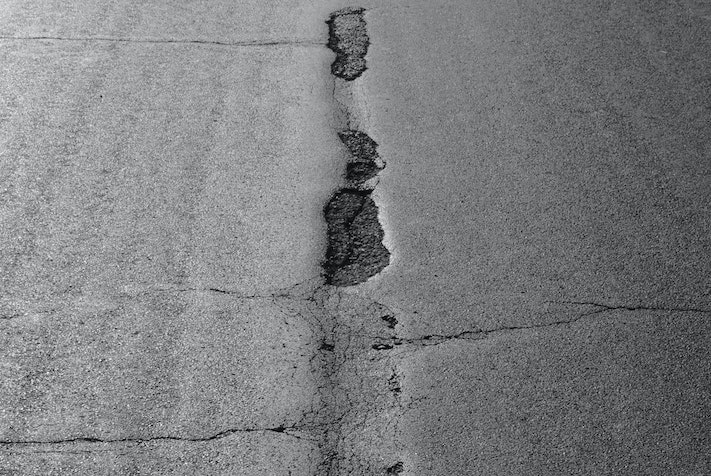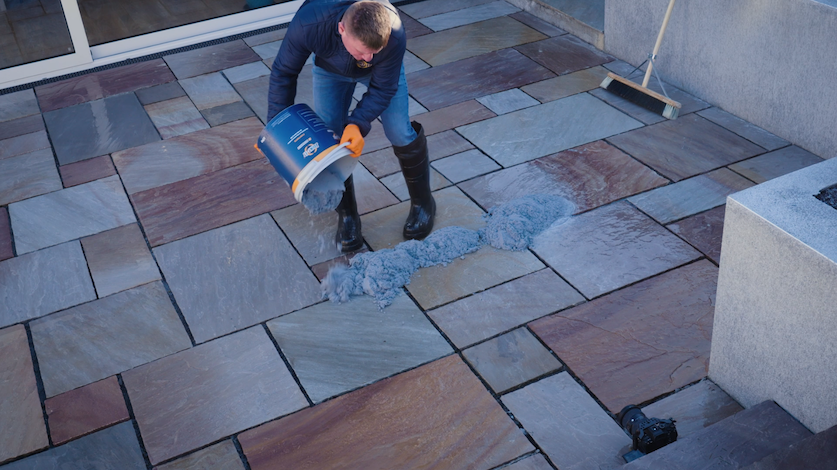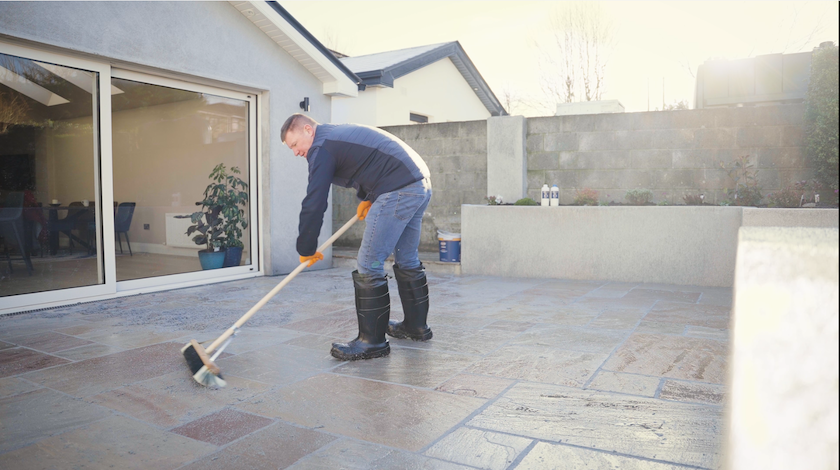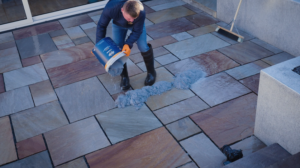Most cold-lay tarmac formulas state they can be applied in all weathers. But is this really the case for permanent pothole fixes? Discover whether tarmac can be laid in cold weather and the best advice for applications during wet conditions.

How does cold weather affect tarmac?
When weather conditions allow, asphalt – including bagged tarmac such as as cold-lay surfacing material – can be applied during colder temperatures.
However, if the ground is frozen or the temperature is likely to drop below freezing, we highly recommend delaying your repair work until the outdoor temperature improves.
The ground must always be free of frost when patching potholes (we’ll explain why in just a moment).
Springtime and summer tend to be the best times of year for road and highway repairs as they often bring some milder weather. But especially here in the UK, we can’t always guarantee clear days and warmer temperatures even at that time of year!
Given that some potholes on busy roads or paths need to be fixed as a matter of urgency, emergency repair work is often required throughout the year.
Read on to delve more into when to avoid laying asphalt, and extra cold weather advice to ensure your team can continue their operations without causing any extra pothole failures.
What is the minimum temperature for patching potholes?
When using a quality bagged tarmac, there is no minimum temperature for applying the materials.
However we do strongly recommend that the ground is not frozen and there should be no risk of frost setting in while the formula cures.
Ground temperature is always a few degrees colder than the outdoor temperature. Keep that in mind when you’re checking your weather app.
Why must the ground be frost-free?
Best practice when patching potholes is for the ground to be absolutely free from frost.
Freeze thaw can occur when you patch a pothole containing any frost. When the frost thaws, the water particles expand, causing the cured formula to be pushed out of the reinstatement.
Another pothole failure – especially after fixing a pothole – is the last thing you’ll want!
For permanent pothole repairs, always check the ground is frost-free before you start work. Also follow our other expert tips below.
Choose a bagged asphalt with more workability
When considering Instarmac’s Ultracrete range of quality bagged asphalt, all of these products have been manufactured to ensure easy working and application, even during colder temperatures – as long as the ground is free from frost.
But you may want to opt for a formula with improved workability.
Ultracrete’s Tough Patch Rapid formula offers increased workability and is certified for use through the Product Assessment Scheme (PAS).
While other formulas cure through compaction, the Tough Patch mix (also available in 25kg bags) is activated by sprinkling water on each layer. This also means it’s an ideal formula to use during wet weather.
Read on to find out more about using bagged tarmacs in the rain and the recommended formulas to use.
Can asphalt formulas actually freeze?
Much the same as other asphalts, bagged tarmacs such as Instant Road Repair and Permanent Pothole Repair do not contain any ingredients that will freeze.
That said, for permanent pothole fixes, you still need to take care when working with these materials so you don’t create the conditions for another failed pothole further down the track.
As mentioned earlier, always make sure the ground is free from frost and that the temperature is rising.
On those colder mornings, start your operations later in the day when the temp is likely to be slightly warmer.
If you’re using a water-activated formula, ensure the hose pipe you’re using to apply the water is free from ice.
Can you lay bagged tarmac in the rain?
Although dry conditions are best for laying tarmac, some bagged asphalts can take a little light rain during application.
However, you must keep an eye on the weather. Heavy rain will add excess water to the formula and will likely cause your pothole repairs to fail.
Superior asphalts for wet weather
Some bagged tarmac formulas are made specially to cope with wet weather conditions.
PPR Wet is one of the formulas that can be used in the rain.
As a modified version of Permanent Pothole Repair, PPR Wet contains enough anti-wash agent that prevents the binder from washing out during wet weather. As such, it offers more durability when applied during the rain.
PPR Wet has one of the highest polish stone values (PSVs) around, which is a clear indication of a high skid resistance. It’s ideal for planned and reactive repairs on roads, pavements, driveways and car parks.
With a staggering value of 88 PSV, PPR Wet by far exceeds the industry recommendation of 50 PSV.
Mentioned earlier, Tough Patch Rapid is another formula that is ideal for use during the rain. And as a water-activated formula, when it is raining you don’t need to add that much more water to the mix!
With an innovative and reactive binder, Tough Patch is a robust formula that, unlike PPR Wet, can be used on heavily trafficked areas. This is due to the material’s high deformation performance and exceptional rut resistance.
Tough Patch’s setting time is also something to shout about.
After patching a pothole with most cold-lay tarmacs, you generally need to wait six months before you conduct a core test.
But due to the fast-setting and robust nature of Tough Patch, you can do a core test after just 24 hours!
Tough Patch is available as a 6mm-grade and 10mm-grade formula, which are used to fix reinstatements of up to 60mm and 100mm deep respectively. Tough Patch 10mm can be ordered over the phone – call us on 0330 122 1025.
Both Tough Patch grades are PAS approved and made in accordance with the Specification for the Reinstatement of Openings in Highways (SROH).
Bedding mortar for wet weather conditions
Most resin-based bedding mortars cannot be applied during wet weather. But there are high-performance alternative formulas you can use.
A resinous bedding mortar that can be applied during the rain is Envirobed HA104 and, the easier to apply, Envirobed HA104 Flowable.
Along with being able to accommodate wet weather conditions, both formulas can be used during temperatures as low as 1ºC.
These eco-friendly resin mortars feature superior strength for utility reinstatements in heavily trafficked areas. They aid lateral stability and combine as a bedding mortar and backfill.
When it comes to strength, the proof is in the pudding. The standard formula boasts a compressive strength of 53N/mm2, while the flowable formula is 44N/mm2 – and both within just 3 hours.
After application the area can be opened to traffic within one hour!
Both formulations conform to HA104/09 and are BT LN550 and LN320 compliant.
Allow extra time for curing
When laying tarmac during colder weather you may need to wait a little longer for the formula to properly cure.
Cold-lay mixes from Ultracrete, such as IRR, PPR and Tough Patch, all cure instantly. When using these formulas during colder temperatures you really shouldn’t notice much of a difference in curing time.
The hot-lay formula in a bag – Enviro Mastic – takes roughly 45 minutes to cure on a hot, sunny day. Allow around 1 hour during cold weather.
Don't forget cold-joint spray & overbanding tape
Whatever the weather, when patching potholes it’s important to follow the instructions of cutting out the pothole with straight edges and layering the formula into the hole.
Applying cold joint spray to each inner layer provides the adhesive strength required to help ensure your repair job really lasts.
Likewise, apply a quality thermoplastic overbanding tape such as Instaband Eco around the edges of the tamped down pothole to avoid water ingress – one of the major causes of pothole failures.
Storage advice for bagged tarmac
Each Ultracrete formula is manufactured on what they refer to as a ‘just in time basis’ so you have the freshest material to use.
Despite this, cold-lay tarmac can be affected by cold weather while it is in storage. The formula may appear to have gone slightly hard while in the bag or tub.
Luckily, a slightly firm bag of formula is very easy to remedy. Read our guide on how to soften bagged asphalt that has gone hard to find out more.
You can take steps to stop formulas from hardening with these expert storage tips:
- Store unopened bags or tubs in a cool area that’s well ventilated
- Elevate products off the ground on a pallet or shelving unit
- Ensure the area is free from draughts
- Keep an eye on your stock to use formulas before the use-by-date
Please note: the advice provided in this article is based on the guidance offered by Instarmac for the Ultracrete range of permanent cold-lay surfacing materials (PCSMs). Alway read the manufacturer’s instructions before applying any bagged asphalt.








